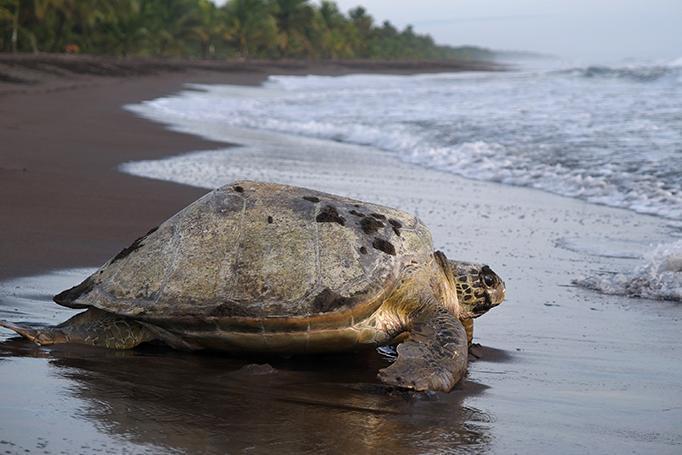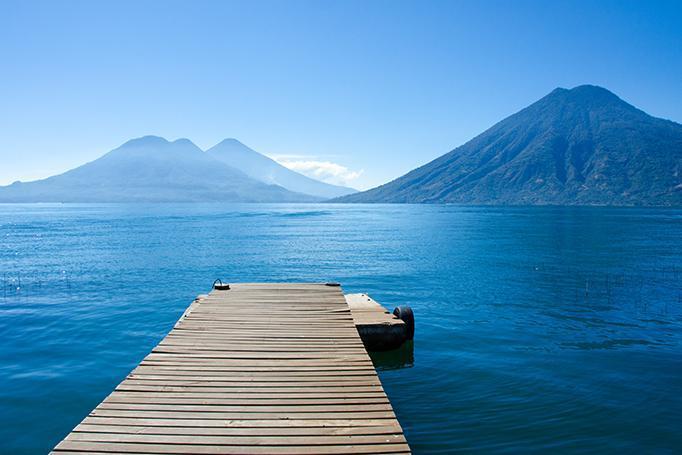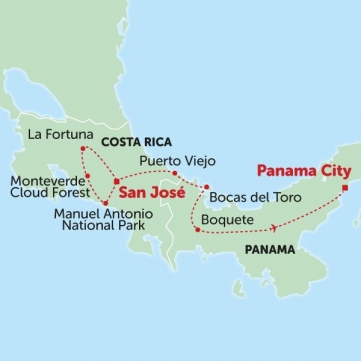Book NOW for $1 £1 €1 • Flexible Payments • No Change Fees • Private Departures Available
- Home >>
- Destinations >>
- Central America >>
- Panama
Panama Tours
Take a Panama adventure tour by boat to the tranquil Bocas del Toro Islands which offer the visitor a great diversity of attractions and natural environments including luxurious rain forests with an abundance of fauna and flora. These sunny islands have beaches that compete with the Caribbean's best.
Discover the highlands on a Panama adventure tour and the charming mountain village of Boquete which is located on the eastern slopes of the Volcan Barú and has a cool climate in contrast to the coastal regions. Known for its sweet oranges and the richest coffees in all of Panama, the coffee beans are primarily picked by the Guaymi Indians during the festive months of October through February. For those hungry for activities on a Panama adventure tour, there are world class rafting facilities, mountain biking, rock climbing and rappelling at nearby Los Ladrillos in Bajo Mono. Resplendent Panama City is the crossing point to South America and home to the infamous Panama Canal which is definitely worth a visit, you could even hop on board one of the regular canal transits.
All Tours of Panama
1 Tours
Panama Travel Articles, Inspiration & Information

Reasons to visit Central America in September
Panama is beautiful in the “green season” and also has great rivers that benefit from the rainfall. Try your hand at kayaking or rafting in its rivers from Boquete. There are also several coffee plantations whose flora will flourish in the green season whose flora will flourish in the green season.. Read more

Tour Leader Insights: An Interview on Central America
We have managed to pin down two of our amazing Central America tour leaders for a short interview on a lowdown of their favourite continent, before they go whizzing off taking more excited passengers on an adventure of a lifetime! This article is perfect for anyone planning their next adventure to Central America.. Read more
Independently Verified Travel Reviews From Past Clients
Panama Travel Guide
Panama Travel Guide
Brief history
Panama is known as the crossroads of the world with its spectacular manmade canal linking the Pacific with the Atlantic. Due to its position it has always been a major shipping point to and from South and Central America and has been shaped ever since by the evolving world economy. Panama was explored by Columbus and settled by the Spanish in the 16th Century. After declaring independence in 1821, Panama became a region of Gran Columbia. Panama then became a protectorate of the United States due to their strategic interest in the construction of an Atlantic-Pacific link, which later became known as the Panama Canal. Construction finished in August 1914 and Panama remained under effective American control until 1939, when the United States finally gave up the legal right to use its troops outside the borders of the Canal Zone. In 1968, Omar Torrijos Herrera took control of the government and negotiated a treaty with the United States for Panama to regain control of the Canal Zone on 1 January, 2000.
Geography and weather
Panama is located in Central America, bordering both the Caribbean Sea and the Pacific Ocean, between Colombia and Costa Rica. An almost impenetrable jungle forms the Darien Gap between Panama and Colombia.
Panama has two seasons. The dry season lasts from mid-December to mid-April while the rainy season goes from mid-April to December. North of the mountains, on the Caribbean side of Panama, it rains all year round. It tends to rain less in February, March, September and October. Temperatures are typically hot in the lowlands throughout the year; days usually reach around 32°C. The hottest months are March and April.
Visit www.worldclimate.com to get an idea of what the weather will be like on your tour.
Visas
Most nationals do not need a visa to enter Panama, but it is important to check the rules for your nationality with your nearest embassy or consulate. For some nationalities you need to buy a tourist card at the point of entry. Entry is granted on production of a passport valid for more than 6 months. You will also be given a tourist card which is issued for 30 days and is renewable at the immigration office in Panama. You may also need an onward flight ticket or evidence of one, and proof that you have funds to support yourself. As a tourist you are entitled to stay 30 days, however depending on the immigration official you may be allocated fewer days. Visitors exceeding 30 days will need an exit permit stamped in their passports before leaving.
You will probably be asked to fill out an immigration card. A copy of this card should stay in your passport until you exit the country.
Money
The local currency is the Panamanian balboa, which is pegged to the US dollar. US-dollar notes and coins are legal tender and many prices are quoted in US dollars.. For up-to-date exchange rates with your own currency visit www.oanda.com or www.xe.com.
Some stores may be reluctant to accept $50 and $100 notes because of counterfeiting, so it is recommended to bring smaller denominations. It is also recommended to retain smaller denominations for boarder crossings etc. There is no restriction on the amount of foreign currency that you may bring into Panama however very large sums should be declared on arrival.
Often the easiest way to obtain local currency is to use an ATM . There are ATMs throughout Panama. In Panama City there are ATM machines at branches of Telered, and Visa, Plus and Cirrus/Maestro are accepted in most ATMs in Panama City.
Do not rely on your card as your only source of money. Always have a few back-ups with you.
Tipping
In some restaurants a 10% service charge is included on the bill, and if it is not included it is expected, as gratuities are a large part of their wages. If you want to tip extra on top of this it is optional. You do not need to tip taxi drivers, but you should tip people who assist you with your luggage at hotels (don’t over-tip – US$0.50 to US$1 or so is fine). Tipping guides at the end of excursions is always appreciated and your tour leader will advise you on this.
Security
Crime in Latin America is not as bad as its reputation as long as you are sensible and alert. Like anywhere in the world, you can be in the wrong place at the wrong time. Care should be taken, especially whilst walking around the larger cities. Try to keep away from dark quiet areas if on your own, particularly late at night and try to always take a taxi.
We suggest that whenever possible you leave all of your important documents in the safe (“caja fuertes”). However you should always carry some form of ID or a photocopy of your passport.
It is advisable not to wear expensive looking watches or jewellery. Keep your camera concealed when not in use. Remember that most thieves don't use violence but rely mostly on diversionary tactics which can take place at anytime of the day or night. Do not be paranoid, but just be aware that it could happen at anytime. Always be vigilant and the chances are nothing will ever happen to you. The safety of our passengers is our tour leaders’ number one concern and they will provide all necessary local information during the pre-departure meeting.
Local food and drink
There is a wide variety of international cuisine for all taste buds.
Your tour leader will be able to recommend restaurants.
There is a lot of different food to choose from in Panama and travellers are often surprised by the quality and variety on offer. There is also local cuisine to suit every budget.
Local cuisine is simple and tasty. The staple food of Panama is white rice and is usually served at every meal along with some sort of meat or fish. The national dish is sancocho de gallina, a chicken stew with pieces of corn on the cob, potatoes and onions. A typical breakfast consists of scrambled eggs along with fried flour and fried corn meal.
A typical lunch consists of a rice and beans (also called ‘gallo pinto’), supplemented by some sort of potato or plantain, and chicken or some other type of meat or stew. Vegetables do not form a large part of the diet, but there is always salad.
If you are a strict vegetarian be sure to stress 'no carne, cerdo, pollo, pescado. You may experience a distinct lack of variety in the food available, especially in small towns. You might find that you are eating a lot of omelettes and other egg dishes. Our tour leaders will do their best to provide interesting vegetarian alternatives when arranging group meals in the campsite, but your patience and understanding is requested.
All drinks such as water, soft or alcoholic drinks are at your own expense at all times.
Panama is one of the best coffee producers in the world, however coffee can be hit or miss in different regions of Panama because much of the highest quality beans are exported all over the world. Coffee is traditionally served strong and mixed with hot milk, however now they have options in most tourist locations such as cappuccino, lattes and even mochas. If you ask for tea (“té negro”) you will get teabags. Always ask for “leche fria a parte” (cold milk on the side) as the alternative is likely to be a hot cup of milk with a tea bag inside.
If you only learn one word in Spanish it’s bound to be Cerveza. There are countless lagers, and a few dark beers. The most common are national beers (Balboa, Atlas, Soberana, Goldbest, Panamá), but you can find some imported beers if you prefer. Balboa is the best of the domestic brands. Beer can cost as low as 35 cents for a 30cl can.
Carta Vieja is the main domestically produced rum. Seco, a very raw white rum, is the national liquor. Seco con leche (with milk) is a common drink in the countryside.
Time Difference
The time difference in Panama is GMT/UTC - 5. For other time differences please visit www.timeanddate.com
Voltage
110 volts, US-style two flat-pinned sockets.



